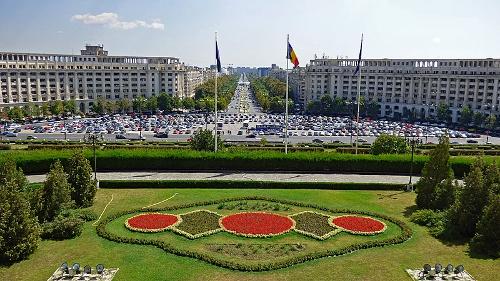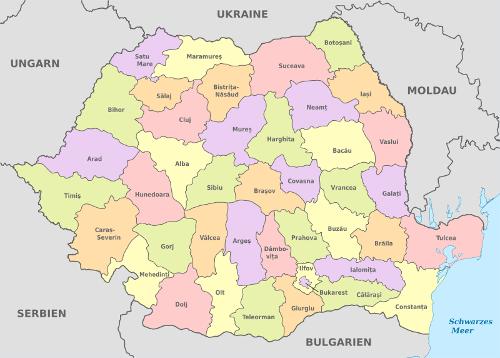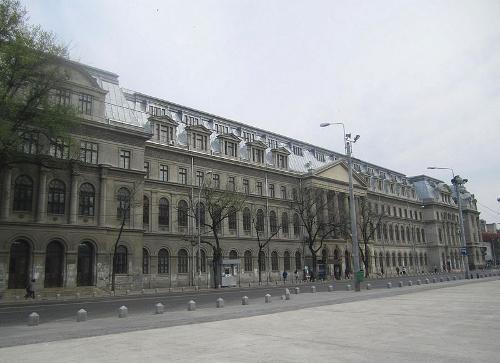ROMANIA
Society

Society
Cities in ROMANIA
| Brasov | Bucharest |
Society
State structure
 Parliament building RomaniaPhoto: Arvid Olson in the public domain
Parliament building RomaniaPhoto: Arvid Olson in the public domain
On December 13, 1991, a new constitution entered into force, stating that Romania is a parliamentary republic with a president as head of state. A year earlier, a new electoral law had already been enacted, allowing for the first time since the Second World War to be held free democratic again.
Every citizen of 18 years and older is entitled to vote and from 23 years old can stand for election to the House of Representatives (Camera Deputatilor, 345 seats).
The members of parliament are elected by universal suffrage that takes place every four years through a district system. Thirteen seats in the House of Representatives are reserved for representatives of ethnic minorities. To be elected to the Senate (Senat, 140 seats), one must even be at least 35 years old. Elections for President, House and Senate take place on the same day.
Both chambers have the same powers. For example, laws can only be passed by a majority of votes in both chambers. When a bill is passed by one chamber and rejected by another, the chamber that passed the bill has to rethink it. If the bill is rejected by the other chamber for the second time, the bill will be definitively withdrawn.
Since 1990, the legislative, executive and judicial branches have been separated. The president and the government together form the executive power in Romania and the constitution therefore describes the country as a semi-presidential republic.
Presidential elections take place every four years. If no presidential candidate scores more than 50% in the first round of the presidential election, a second round will follow. The candidate who receives the highest number of votes in the second round becomes president. The president can be elected for up to two terms. The role of the Romanian president is quite significant.
For example, the government is headed by a prime minister, but the president appoints and dismisses ministers. He can also dissolve parliament within 60 days if this institute has withdrawn its confidence in the government. Furthermore, the president is the commander of the military and chairman of the Supreme National Security Council or Supreme Defense Council. For the current political situation see chapter history.
Administrative division
 Map of the 41 districts of RomaniaPhoto: TUBS CC 3.0 Unported no changes made
Map of the 41 districts of RomaniaPhoto: TUBS CC 3.0 Unported no changes made
Romania is divided into 41 districts, which in turn are subdivided into municipalities with extensive powers, cities and country municipalities. The capital Bucharest is its own region.
The government appoints a prefect for each district to represent the government at the local level. A prefect supervises the activities of the decentralized ministerial and other central bodies.
Education
 University of Bucharest, RomaniaPhoto: Crislia CC 4.0 International no changes made
University of Bucharest, RomaniaPhoto: Crislia CC 4.0 International no changes made
About 4% of GDP is spent on education, which is low compared to European standards. The current school population is expected to attend an average of 11-12 years of education, significantly more than a few years ago. The number of students in higher education is also increasing sharply.
Education in Romania is free from pre-school to university education. According to law, there is compulsory education for children from 7 to 16 years old. In reality, many children hardly go to school, especially in rural areas where they often have to help their parents to earn a little more money.
Children from 3 to 6 years old go to kindergarten. When the children are 7 years old, they go to eight-year-old primary school. In the last year, the children have to take exams. Based on the exam results, they can choose between two further courses: the four-year high school, which prepares the children for university studies, or the two-year secondary school, which provides a link to vocational education. Pupils who have completed their high school education with good grades are allowed to take the entrance examination for the state universities. They can also go to a private university, for which the entrance exam is less difficult. However, these institutions have to be paid dearly. The vocational training that follows secondary school lasts four years.
A number of private secondary schools and universities have opened since 1989. Approx. 32% of all school-age children and students attending now have private education. The number of students in secondary education has fallen dramatically since 1990, from 90.7% in 1990 to only 68% in 1999. The number of students in university education, on the other hand, has increased, from 10% in 1990 to 25.4% in 1998 The best Romanian universities can be found in Bucharest, Iasi, Cluj-Napoca and Timisoara.
English and French are taught in all secondary schools. Hungarian, German, Serbian and Ukrainian is taught in areas where many people from these minority groups live.
Sources
Bos, J.W. / Roemenië : mensen, politiek, economie, cultuur, milieu
Koninklijk Instituut voor de Tropen
Democratisering aan de Donau : Roemenië na de revolutie van 1989
Instituut voor Publiek en Politiek
Roemenië
Steunpunt Oost-Europa Projecten
Versteegen, J. / Roemenië
Gottmer
Williams, N. / Romania & Moldova
Lonely Planet
CIA - World Factbook
BBC - Country Profiles
Copyright: Team The World of Info